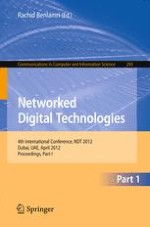This two-volume-set (CCIS 293 and CCIS 294) constitutes the refereed proceedings of the International Conference on Networked Digital Technologies, NDT 2012, held in Dubai, UAE, in April 2012. The 96 papers presented in the two volumes were carefully reviewed and selected from 228 submissions. The papers are organized in topical sections on collaborative systems for e-sciences; context-aware processing and ubiquitous systems; data and network mining; grid and cloud computing; information and data management; intelligent agent-based systems; internet modeling and design; mobile, ad hoc and sensor network management; peer-to-peer social networks; quality of service for networked systems; semantic Web and ontologies; security and access control; signal processing and computer vision for networked systems; social networks; Web services.
